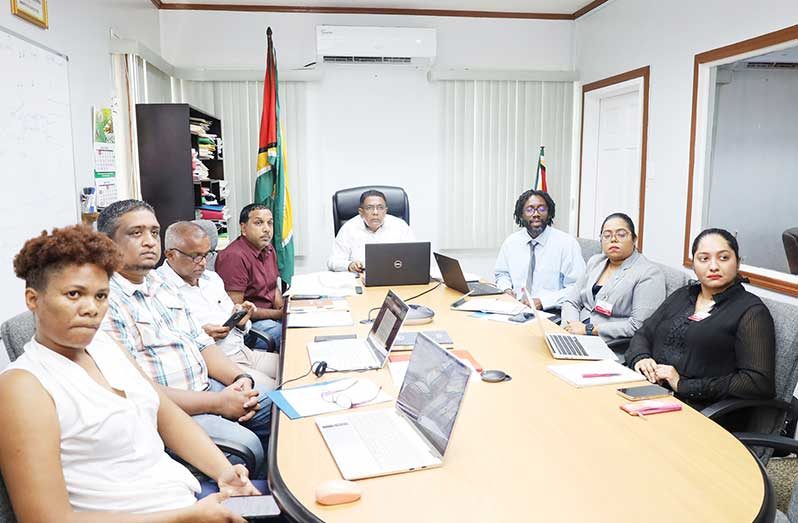-expected to boost flood-management efforts, complement government’s investment in sector – Minister Mustapha
THE Government of Guyana through the Ministry of Agriculture on Tuesday, along with representatives from the Global Green Growth Institute (GGGI) and the Infrastructure for Resilient Island States (IRIS) Project, met to discuss a project aimed at developing a strategic sustainable integrated national drainage and irrigation system in Guyana.
Guyana is one of the first countries to implement the grant-funded project, which was designed to support the Ministry of Agriculture in developing an integrated strategy for drainage and irrigation for the period 2025-2030.
The project is being implemented by the IRIS through the Coalition for Disaster Resilient Infrastructure’s (CDRI) Infrastructure Resilience Accelerator Fund with financial support from the governments of India, Australia, the United Kingdom, and the European Union to the tune of US$499,989.
While speaking with those in attendance, Agriculture Minister Zulfikar Mustapha said that the project was designed to align with the Low Carbon Development Strategy 2030 and enable inter-ministerial collaboration on drainage and irrigation, and flood-management efforts.
“The Government of Guyana’s development of its low-carbon and climate- resilient trajectory has recognised adaptation and flood management as critical to Guyana and its citizens and continues to make significant investments in capital and other works to support integrated sustainable solutions for drainage and irrigation.
This project is hoped to support and complement the investment the government is making.
GGGI’s support to help THE National Drainage and Irrigation Authority (NDIA) integrate nature-based solutions into protecting Guyana’s coastal assets and communities is appreciated at this time with the kind financial support of the IRIS and the CDRI,” he explained.
He also said that while the project is geared towards developing a strategic, sustainable, integrated national drainage and irrigation system in Guyana, it will also complement efforts to move the food-production systems forward in keeping with CARICOM’s Vision 25 by 2025 objectives to reduce Guyana’s food imports by 25 per cent by 2025.
Among the five objectives, the project seeks to support the NDIA in the development and publication of an updated Integrated Strategy for Drainage and Irrigation (ISDI) and to enable asset-monitoring and data-collection systems that help the drainage authority to implement its ISDI and prioritise nature-based solutions and social inclusion in D&I systems.
Meanwhile, Chairman of the NDIA, Lionel Wordsworth, said that the flooding Guyana experienced in 2005 exposed the vulnerabilities of the country’s coast.
This, he added, led to subsequent infrastructural interventions such as the Hope Canal which proved critical and immensely valuable in recent years.
The NDIA Chairman also said that through funding from the Government of Guyana, the NDIA is currently working to develop similar drainage interventions to that of the Hope Canal in other regions along the coast.
Project Manager Ronald Cumberbatch also noted that a strategy is currently being developed in collaboration with the NDIA and other stakeholders. This strategy, which serves as a critical component of the project, will be completed by the end of 2024.
The technical studies and data-collection activities that will provide the information to formulate the strategy have commenced.
The project, which is expected to be completed by the end of March, 2026, will also enable the ministry to fulfil its objectives within the LCDS2030 and offer national strategic leadership in agricultural production and flood management.
It will also facilitate capacity building for engineers attached to the NDIA.
CDRI comprises 39 member countries and seven international institutions and provides technical support to projects being implemented with its funding.
The second call for submission of project proposals was launched by the CDRI at the Fourth International Conference on SIDS in Antigua and Barbuda. The deadline for submission is the end of August, 2024.



.jpg)








